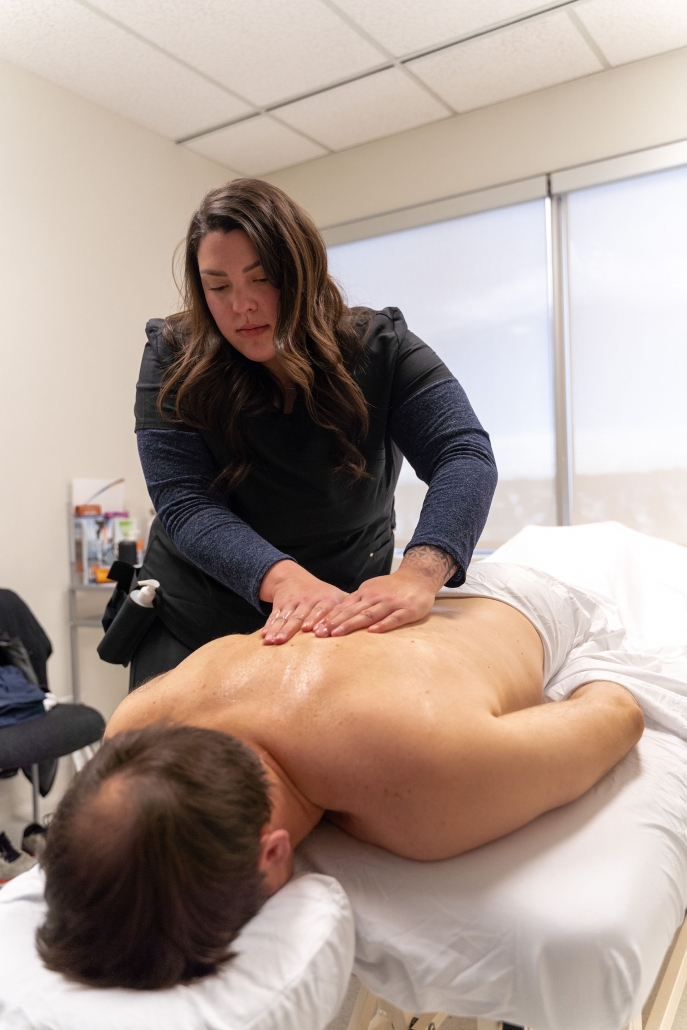The massage therapists at Elite Sport Performance are registered and experienced in treating a variety of ailments from sports related and overuse injuries, to MVA cases, to treating the tightness that comes with spending hours seated at a desk – see more about occupational risk factors and symptoms (Infographic). We like to impart on our patients the fact that MAINTENANCE is key when it comes to massage therapy! We suggest regularly scheduled treatments (every 2-6 weeks, depending on each individual).
The potential benefits of massage may include but are not limited to:
- Increased range of motion by adding motion into the treatment itself
- Increases or maintains flexibility
- Functional healing of muscles and improved recovery
- Increases circulation
- Decreases spasms and muscle fatigue
- Allows for maximization of training
- Injury prevention by relieving hypertension in muscles and tendons and in turn reducing excess strain on joints
- Decreases scar tissue and adhesion
- Improves muscle and bodily awareness (proprioception)
- Decreased pain by activating the parasympathetic response and relieving pressure or tension
- Promotes relaxation, and decreases stress, anxiety and depression
We always offer the tailoring/personalization of the treatment on a patient by patient basis.
Our therapists may employ any one of many techniques in the treatment of a patient. These may include, but are not limited to: hydrotherapy, myofascial release, manual lymphatic drainage, static pressure, trigger point release, cross-fibre frictions, breath work, joint mobilizations, passive stretching, active inhibition and cupping.
Cupping
What is Cupping?
Cupping is a therapy in which glass jars or cups are suctioned onto the skins surface with negative pressure. Traditionally, cupping has been used in Chinese medicine for 1000s of years to open up meridian pathways to allow Qi to flow through. When Qi flows freely throughout the body one enjoys good physical, mental and emotional wellbeing.
Cupping uses suction and negative pressure to drain excess fluids, stimulate the parasympathetic nervous system (relaxation) and increase blood flow to muscles and skin. It can be used along Meridians and acupuncture points to clear colds and flus and stimulate specific organs, it can also be used along fascial lines across the body to specifically treat fascia and muscles
Why treat fascia? Fascia is connective tissue (has an appearance like a spider web) that covers everything within our bodies – muscles, bone, nerve, organs etc. – it is the 3D glue that holds everything together. It is what allows our muscles to slide/glide efficiently. A fascial dysfunction can restrict range of motion, decrease blood flow to an area, and cause pain and toxin build up.
Cupping is different than most manual therapy in that the majority of other techniques use compression, whereas Cupping decompresses (lifts, separates and stretches) tissue to release adhesions and break down existing scar tissue, relax muscle spasms, and decrease trigger point pain. It has also been shown to decrease tissue changes (scar tissue formation) and inflammation following trauma.
What are the marks left by cupping?
- Marks can vary in pattern and color from red to dark purple
- Can last anywhere from 3 days to 2 weeks depending on health, activity level and severity of trauma to the area
- Marks are not bruises and are rarely sensitive to the touch
- They are static blood, lymph, cellular debris, pathogenic factors and toxins being released from deeper tissue layers
- Clearing this stagnation stimulates oxygenated blood to nourish and heal the targeted areas
- As the stagnation clears over a series of treatments the marks will lighten and eventually cupping will leave no marks at all.
Who can benefit from Cupping?
- Anyone with joint or muscle pain/tension, headaches, frequent colds or flu
- Ideal for those who are not getting the relief they need from regular massage therapy treatments
- Often can offer the results of a deep tissue massage with less discomfort.
- Very effective in treating chronic overuse injuries such as bursitis, tendonitis and other myofascial pain syndromes such as runner’s knee, tennis elbow, and low back pain.


